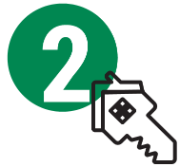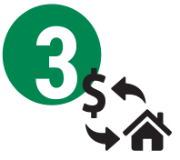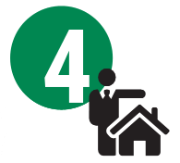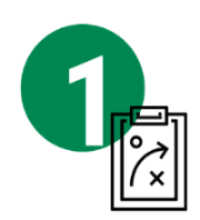
Mortgage 101

- Tab 1What to Know Before You Buy
- Tab 2First Time Home Buyers
- Tab 3Types of Mortgage Loans
- Tab 4Mortgage Refinancing
- Tab 5Home Equity Line of Credit (HELOC)
- Tab 6Life After Your Mortgage is Paid
What to Know Before You Buy
Stage 1: Planning for a Mortgage
Growing and building credit
- Pay your bills on time in the years leading up to a potential loan of any kind.
- Loan programs through Freddie Mac and Fannie Mae require you to show 3 loans in your past with at least 12 payments reported under each loan.
Be mindful of changing jobs or careers
Lenders want to see stability in your employment and your career.
- An English teacher leaving one high school to teach English at another high school shows career consistency. However, the teacher may need to have started working at the new school before applying for a mortgage.
- An English teacher who changes careers to start a new job in sales or customer service is not showing career consistency and the lender may require an explanation in the loan application process.
Documentation will always be required to prove current and past employment status.
- Two (2) most recent W2s plus one (1) month of paystubs
- Self-employed: Two (2) most recent tax returns
- Applicants who want to have overtime hours included must have a history of 18 months or more with their current employer. The 18 month history helps show the seasonality of the overtime pay earned. For example, someone working outside may show a large amount of overtime during the summer and very little work during the winter.
What can I afford?
Start with a budget
- Determine your total gross monthly income. Gross income is the amount before taxes are taken out.
- Banks calculate a debt versus income ratio to help determine how much you can afford. Typically, 60% of your income is set aside for “living expenses” (i.e. groceries, utilities, clothing, entertainment). The other 40% of your income is set aside for debt payments such as mortgages, auto loans, credit cards and other traditional loans.
- When considering how much you can afford, calculate the total amount of your gross income that is used to make debt payments today. Are you using more (or less) than 40% of your gross income for debt payments?
- Remember, homeownership has additional costs in comparison to rent, such as homeowner’s insurance and real estate taxes.
Check out our mortgage loan calculators to help you get started!
 What to Know for First Time Home Buying
What to Know for First Time Home Buying
Stage 2: First home purchase
Down payments
- Funds for a down payment traditionally come from a borrower's savings
- The amount needed for a down payment varies depending on the mortgage product chosen by the borrower
Can a down payment be borrowed?
A down payment cannot be borrowed. However, some loan types will allow you to use a gift from an immediate family member to help with the down payment. Typically, the family member will need to sign a gift letter explaining that the funds are truly a gift and are not required to be repaid.
Loan Application
A loan officer will explain and collect documents necessary to submit an application.
- Personal information for the borrower, including social security number, date of birth, and employment status
- Income information for the borrower
- Home purchase details, including the new home address and purchase price
Loan Underwriting
Once the borrower has submitted an application, an underwriter reviews it and determines if the borrower meets the requirements to proceed with the purchase. The underwriter will provide the loan officer and the borrower with one of the following decisions:
- Approved: In this case, the home appraisal, title search on the property, and verification of assets for the down payment would still need to be completed.
- Counter Offer: This typically happens when the loan amount is too high for the borrower income to support, so the financial institution will offer to provide a lower mortgage amount.
- Denied: The borrower will receive correspondence from the financial institution listing the reason for denial.
Loan Closing
If the underwriter approves the loan to move forward, the closing process begins.
- Home Appraisal- The financial institution will review the appraisal to ensure the home is valued at or above the purchase price
- Home Inspection (optional)- Borrowers may choose to have an inspection completed prior to finalizing the purchase
- Mortgage Filing- Transfer of property into borrower's name
Types of Mortgage Loans
Learn More About the Types of Mortgage Loans
Fixed Rate vs Adjustable Rate Mortgages
What is the difference?
- Adjustable Rate Mortgages (ARMs): The interest rate is not guaranteed to be the same rate for the life of the loan. ARMs may have an initial time period at the start of the loan when the interest rate is fixed. The initial rate lock period can range from a few months to 15 years.
- Fixed Rate Mortgage - Fixed rate mortgages guarantee the interest rate for the life of the loan.
Secondary Market Loans
What are the details?
In-House or Internal Loans
What are the details?
Which loan type is right for you?
Comparing a 15-year mortgage and a 30-year mortgage
| Breakdown | 15-Year Mortgage |
30-Year Mortgage
|
|---|---|---|
Mortgage Amount |
$100,000 |
$100,000 |
Interest Rate |
6.875% |
6.625% |
Monthly Payments |
$892 |
$640 |
Total Monthly Payments over the Term of the Mortgage |
$160,534 |
$230,513 |
Total Principal Paid over the Term of the Mortgage |
$100,000 |
$100,000 |
Total Interest Paid over the Term of the Mortgage |
$60,534 |
$130,513 |
Prepared for informational purposes only. Values are rounded to the nearest dollar.
ARM - Adjustable Rate Mortgage
A mortgage in which interest is payable at a variable rate according to a predetermined formula. The interest is typically tied to the prime rate or another interest rate.
There are several features of ARMs that you should evaluate if you are considering this type of mortgage.
- Initial rate. Be careful if the initial rate seems real low. It could be a "teaser" rate that only lasts for a short time and then the rate is adjusted upward. At a minimum, ask what the rate would be adjusted to if the initial rate ended today.
- Benchmark the ARM is pegged to. ARM rates are usually tied to some "published" index that reflects the general interest rate market. Usually the ARM rate is adjusted to that benchmark plus some level of margin. Ask the lender how this works and try to get an understanding of how the benchmark rate has changed recently.
- The cap. Most ARMs have limits on how much the rate can rise in any one year and some ARMs have a limit to what the rate can rise to over the course of the mortgage. Understanding how the caps work will let you know "how bad it can get" if rates rise substantially.
- Length of the rate periods. When you look at ARMs you may find there are terms like 10/1, 7/1, 4/1 and the like. These refer to how long the initial rate lasts and how often the rate is adjusted after that.
Adjustable rate mortgages are attractive because of their lower initial rate. Your risk is that your rate and monthly payment will rise in the future. If you are comfortable that you can accept an increased payment or if you think you will be moving in a relatively short time, the savings with an ARM can be substantial.
Example Rates:
Examples for clarification
- A 1/1 ARM (30 year term) of $75,000, with loan-to-value (LTV) of 80%, at a rate of 3.375% and an Annual Percentage Rate (APR) of 4.162% would have a payment of $331.57 (not including taxes and insurance). The APR includes finance charges of $1,187. The variable rate is subject to change after consummation with a 2.00% cap for each adjustment period, a ceiling of 6.00%, and a floor of 3.25%. Other customary closing costs apply.
- A 3/1 ARM (30 year term) of $75,000, with loan-to-value (LTV) of 80%, at a rate of 3.625% and an Annual Percentage Rate (APR) of 4.108% would have a payment of $342.04 (not including taxes and insurance). The APR includes finance charges of $1,187. The variable rate is subject to change after consummation with a 2.00% cap for each adjustment period, a ceiling of 6.00%, and a floor of 3.25%. Other customary closing costs apply.
- A 5/1 ARM (30 year term) of $75,000, with loan-to-value (LTV) of 80%, at a rate of 3.875% and an Annual Percentage Rate (APR) of 4.132% would have a payment of $352.68 (not including taxes and insurance). The APR includes finance charges of $1,187. The variable rate is subject to change after consummation with a 2.00% cap for each adjustment period, a ceiling of 6.00%, and a floor of 3.25%. Other customary closing costs apply.
- A 15/1 ARM (30 year term) of $75,000, with loan-to-value (LTV) of 80%, at a rate of 4.375% and an Annual Percentage Rate (APR) of 4.426% would have a payment of $374.46 (not including taxes and insurance). The APR includes finance charges of $1,187. The variable rate is subject to change after consummation with a 2.00% cap for each adjustment period, a ceiling of 6.00%, and a floor of 3.25%. Other customary closing costs apply.
 Mortgage Refinancing
Mortgage Refinancing
Stage 3: Refinancing your mortgage
Types of Refinancing
Traditional Refinancing
- Lower the monthly payment by stretching the loan balance out over a longer period of time
- Take advantage of a lower interest rate
Cash-Out Refinancing
Home Equity Line of Credit
Stage 3: What is a HELOC?
Features and Benefits
A HELOC can be a simple way to tap into the value (equity) of your home without a complete mortgage refinance. Home equity is the difference between what you owe on your mortgage and what your home is currently worth. HELOC stands for Home Equity Line of Credit and is a second mortgage, which means your home is the collateral.
- Minimal out of pocket closing costs
- Variable interest rate
- Annual fee may apply
How can I use HELOC funds?
HELOCs can be very useful in providing access to funds for home improvements, debt consolidation, and education costs. You may be able to conveniently access your loan funds by simply writing a check or transferring money into your checking account.
 Congrats! Your mortgage is paid!
Congrats! Your mortgage is paid!
Stage 4: Selling, Downsizing, and Using Bridge Loans
The goal for any homeowner is to one day pay off their mortgage. Once you have either paid off your mortgage or paid it down to a substantially lower balance, you now find yourself with usable equity in your home. Home equity is the difference between what you owe on your mortgage and what your home is currently worth.
To use this equity, you may consider a Home Equity Loan or a Home Equity Line of Credit (HELOC). But, what if you are ready to upgrade to a new home or maybe downsize to something more suitable for your current situation? This is when a bridge loan may be the right option for you.
Bridge Loans
A bridge loan allows you to use the equity in your current home to purchase a new home before selling your current home.
- Short term mortgages; typically for a maximum of 12 months
- Minimal closing costs
- Flexible payment options, including interest only payments
costs. There will be appraisal, title, and recording fees for each property involved.

